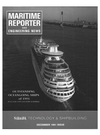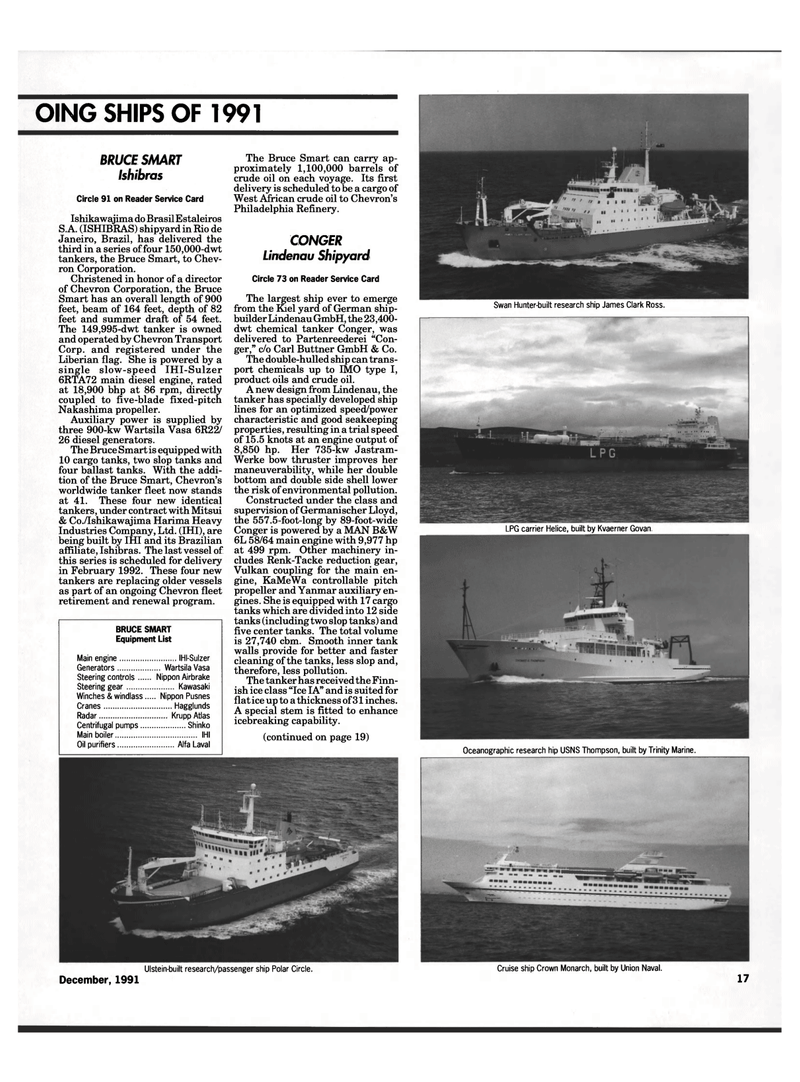
Page 15: of Maritime Reporter Magazine (December 1991)
Read this page in Pdf, Flash or Html5 edition of December 1991 Maritime Reporter Magazine
BRUCE SMART
Ishibras
Circle 91 on Reader Service Card
Ishikawajima do Brasil Estaleiros
S.A. (ISHIBRAS) shipyard in Rio de
Janeiro, Brazil, has delivered the third in a series of four 150,000-dwt tankers, the Bruce Smart, to Chev- ron Corporation.
Christened in honor of a director of Chevron Corporation, the Bruce
Smart has an overall length of 900 feet, beam of 164 feet, depth of 82 feet and summer draft of 54 feet.
The 149,995-dwt tanker is owned and operated by Chevron Transport
Corp. and registered under the
Liberian flag. She is powered by a single slow-speed IHI-Sulzer 6RTA72 main diesel engine, rated at 18,900 bhp at 86 rpm, directly coupled to five-blade fixed-pitch
Nakashima propeller.
Auxiliary power is supplied by three 900-kw Wartsila Vasa 6R22/ 26 diesel generators.
The Bruce Smart is equipped with 10 cargo tanks, two slop tanks and four ballast tanks. With the addi- tion of the Bruce Smart, Chevron's worldwide tanker fleet now stands at 41. These four new identical tankers, under contract with Mitsui & Co./Ishikawajima Harima Heavy
Industries Company, Ltd. (IHI), are being built by IHI and its Brazilian affiliate, Ishibras. The last vessel of this series is scheduled for delivery in February 1992. These four new tankers are replacing older vessels as part of an ongoing Chevron fleet retirement and renewal program.
BRUCE SMART
Equipment List
Main engine IHI-Sulzer
Generators Wartsila Vasa
Steering controls Nippon Airbrake
Steering gear Kawasaki
Winches & windlass Nippon Pusnes
Cranes Hagglund
Radar Krupp Atlas
Centrifugal pumps Shinko
Main boiler IHI
Oil purifiers Alfa Laval
The Bruce Smart can carry ap- proximately 1,100,000 barrels of crude oil on each voyage. Its first delivery is scheduled to be a cargo of
West African crude oil to Chevron's
Philadelphia Refinery.
CONGER
Lindenau Shipyard
Circle 73 on Reader Service Card
The largest ship ever to emerge from the Kiel yard of German ship- builder Lindenau GmbH, the 23,400- dwt chemical tanker Conger, was delivered to Partenreederei "Con- ger," c/o Carl Buttner GmbH & Co.
The double-hulled ship can trans- port chemicals up to IMO type I, product oils and crude oil.
A new design from Lindenau, the tanker has specially developed ship lines for an optimized speed/power characteristic and good seakeeping properties, resulting in a trial speed of 15.5 knots at an engine output of 8,850 hp. Her 735-kw Jastram-
Werke bow thruster improves her maneuverability, while her double bottom and double side shell lower the risk of environmental pollution.
Constructed under the class and supervision of Germanischer Lloyd, the 557.5-foot-long by 89-foot-wide
Conger is powered by a MAN B&W 6L 58/64 main engine with 9,977 hp at 499 rpm. Other machinery in- cludes Renk-Tacke reduction gear,
Vulkan coupling for the main en- gine, KaMeWa controllable pitch propeller and Yanmar auxiliary en- gines. She is equipped with 17 cargo tanks which are divided into 12 side tanks (including two slop tanks) and five center tanks. The total volume is 27,740 cbm. Smooth inner tank walls provide for better and faster cleaning of the tanks , less slop and, therefore, less pollution.
The tanker has received the Finn- ish ice class "Ice IA" and is suited for flat ice up to a thickness of 31 inches.
A special stem is fitted to enhance icebreaking capability. (continued on page 19)
GOING SHIPS OF 1991
Swan Hunter-built research ship James Clark Ross.
Oceanographic research hip USNS Thompson, built by Trinity Marine.
Cruise ship Crown Monarch, built by Union Naval. 17
Ulstein-built research/passenger ship Polar Circle.
December, 1991
LPG carrier Helice, built by Kvaerner Govan,

 14
14

 16
16
